Largest Venomous Snake in World
KING COBRA (Ophiophagus hannah – Thailand King Cobra)
In Greek, ‘snake eater.’ Sometimes called ‘Hamadryad.’ Discovered and described by Danish naturalist, Theodore Edward Cantor in 1836. The species name, hannah reflects the snake’s arboreal habits, from Greek mythology it refers to tree dwelling nymphs of the same name.
IDENTIFICATION

Ophiophagus hannah occupies its own genus, Ophiophagus. This is different from other cobras in the Naja genus which have multiple species within the genus. There has been talk about breaking up the genus into a number of species, as differences exist in coloration, and scalation, and in comparison, king cobras can be easily distinguished by the shape and size of the neck hood. Kings have a longer, thinner hood.
Other cobras grow to a maximum length of around two meters in length – much smaller than king cobras. The king cobra has chevrons lighter in color than the body color, on the neck and body that may be very pronounced, as in kings from China, or muted, as we see on melanistic king cobras here in Southern Thailand.
A technical difference between Ophiophagus hannah and all other cobras is the existence of a pair of scales on the top and rear of the head called, ‘occipital scales.’ They are located adjacent to each other behind the usual 9-scale arrangement typical of colubrids and elapids.
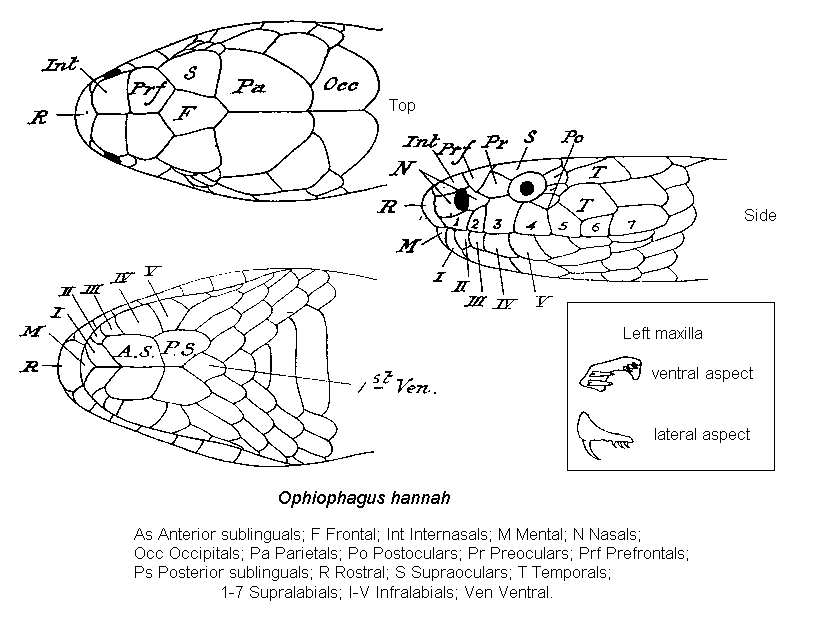
Image from Creative Commons – Wikipedia. Link here.
THAI LANGUAGE
In Thai language, it sounds like Ngoo how chang (literally “snake cobra elephant”, or ngoo chong ahng. There are many names for this snake.
AVERAGE AND MAXIMUM LENGTH
Max length about 5.85 meters. The presenter at the Queen Saovabha Memorial Snake Institute in Bangkok said the largest king was caught in Nakhon Si Thammarat in Thailand’s south, near Surat Thani province and it was 19 feet 2 inches in length.
RANGE
All over Thailand and most of Southeast Asia.
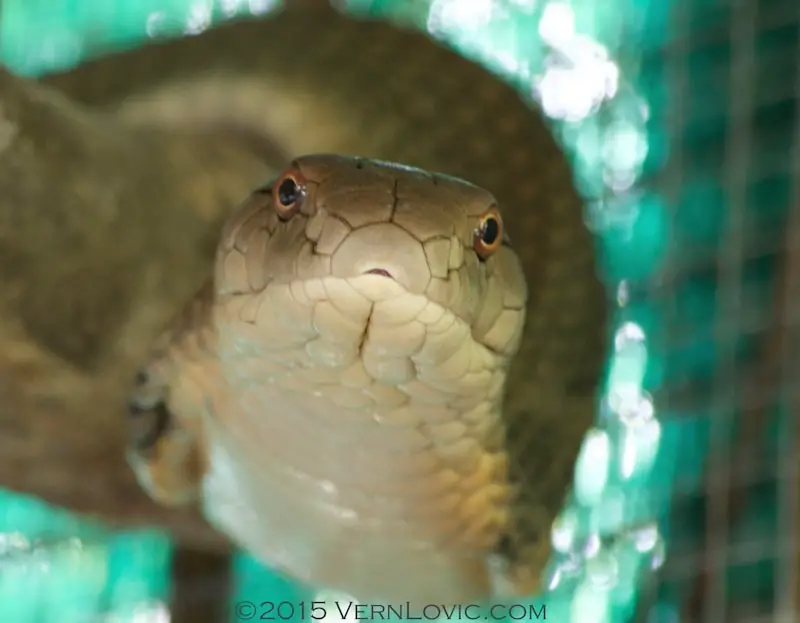
NOTES
I’ve seen a few king cobras (hamadryad) in the wild. One I saw in a park in Krabi – just the tail as it crossed the road behind me. I’m guessing it was an eight-meter long snake. I know it is probably impossible, but I’m not joking. The tail was absolutely massive, longer and thicker by nearly double that of other 5-meter kings I’ve seen many of. This was quite possibly the biggest King Cobra in the world.
Another king I saw on the island of Penang, in Malaysia. I was coming down a very steep hill and I saw this 3-4 meter king cruising through the dense underbrush. It was absolutely awesome to see it there when there were so many people climbing the hill close by.
Another time I saw a king about one-hundred twenty meters in elevation up a limestone mountain in Krabi province. This one rested on the steps of a popular temple – Tiger Cave Temple in Krabi and I had to move it away so people could come down the steps. A large four-meter-long king that was very fast! Note to self – don’t try to move a king that is higher than you are (it was on steps up ahead of me and was very fast to come down to attempt to strike at me because it had the height advantage.
Recently Tom Charlton and I found a 3-meter king cobra in Krabi and got some great shots and videos of it. Facebook photo of it here.
Kings are all over Thailand and can be found near houses, or really – just about anywhere. But they are not found often. They are tremendously strong and smart animals. Please give the snake a large space and do not poke it with a stick.
They are very fast-moving. Juvenile king cobras can also kill you. Their venom is every bit as toxic as adults. One study done by the Queen Saovabha Memorial Institute in Bangkok showed that king venom is actually more toxic the younger the snake is.
KING COBRA HABITAT
Kings like many types of habitats. Dense forest near water and open grasslands. Love bamboo thickets for a nest. The ideal cover is a web of small bamboo growing about a meter high with soft bamboo leaves underneath. The King I found last night was up a limestone mountain around 100 meters in elevation. In Thailand, they are often found wherever rat snakes might be found because they seem to prefer them.
Kings seem to prefer mountains. The other two I found were also at some elevation (200 m and around 500 meters). King cobras are usually terrestrial but have been found many times in trees.
Another interesting bit of information is that the king cobra is said to be able to see as far as 100 meters during daylight.
ACTIVE TIME
The snake is mainly diurnal – found active during the daytime, but can also be active also at night.
FOOD (PREY)
King cobras eat other smaller snakes primarily but also will eat monitor lizards. Occasionally they’ll eat other king cobras, pythons, lizards, birds, and rodents. I saw a 5-meter-long king attempting to eat a 2.5-meter reticulated python.
The King appeared intimidated by the strength of the python – it’s no pushover. Here is a photo of a 3-meter king eating a 2-meter red-tailed racer snake.
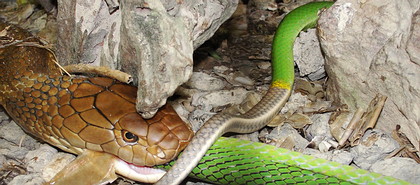
DEFENSIVE BEHAVIOR
Lifts its head off the ground sometimes by as much as 4-5 feet, and flattens out the neck. The hood of a King cobra doesn’t flare as wide… but, a big King will scare you much more because they can be 5 times as long as the monocled or other cobras!
These snakes are not usually that afraid of people and move slowly to ‘escape’ if they move away at all. Last night I moved a 4-meter king off some steps at a local temple so people could pass. It was not in ANY hurry to get away, and it came at me a couple of times. Impressive snakes, and not to be taken lightly.
I know a man personally, his brother was bitten on the upper arm/shoulder and died in less than 10 minutes on the way to the hospital.
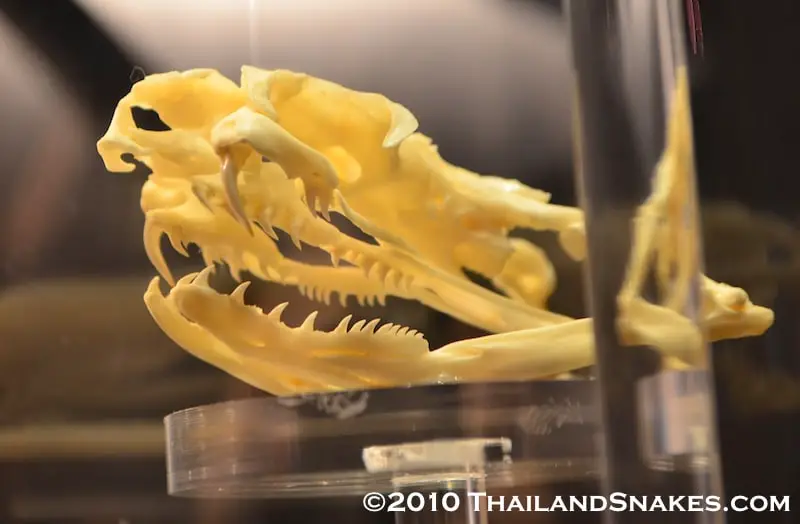
VENOM TOXICITY
Very toxic, but monocled cobras (Naja kaouthia) and kraits (genus Bungarus) are more potent on the LD50 scale. The power of the King is in the volume of venom it can inject in one bite – a maximum of around 7ml! Kings can (and have) killed elephants with a good bite. More information on venom constituents and treatment for king cobra snakebite here.
O. HANNAH ANTIVENOM
There is a specific antivenin for the king cobras manufactured by the Red Cross Queen Saovabha Memorial Institute in Bangkok, Thailand, and available online for about $110 (May, 2015) for enough antivenin to counteract .8ml of king cobra venom.
If the hospital you’re in does not have it in stock and cannot order it quickly from another nearby source, there is an alternative. Tiger snake antivenin can also work well. Online: Snake-Antivenin.com (no affiliation).
OFFSPRING
Ophiophagus hannah is the only snake known in the world that creates a nest (usually of bamboo and other leaves). This snake lays eggs which they stay within the nest until ready to hatch. When the eggs begin hatching, the female king leaves because it eats other snakes primarily – and would likely eat the young.
The young are fast, and deadly from the time they hatch. Juvenile king cobras from Thailand have yellow bands across their black bodies and heads. They look radically different from adult king cobra snakes. There is a danger of mistaking them for mangrove cat snakes (Boiga dendrophila).
Young king cobras spend their early months, and possibly years in the trees. However, recently (Spring 2016) I have found two hatchling king cobras dead on the road in Krabi. Did they attempt to cross the road immediately after hatching while in search of a proper tree to climb? Not sure. Would love to find out. If you have any insight – do let me know!
From Luke Yeomans: “A female usually deposits 20 to 40 eggs into the mound, which acts as an incubator. She stays with the eggs and guards the mound tenaciously, rearing up into a threat display if any large animal gets too close, for roughly 60 to 90 days.
Inside the mound, the eggs are incubated at a steady 28 °C (82 °F). When the eggs start to hatch, instinct causes the female to leave the nest and find prey to eat so she does not eat her young. The baby king cobras, with an average length of 45 to 55 cm (18 to 22 in), have venom which is as potent as that of the adults.
They may be brightly marked, but these colors often fade as they mature. They are alert and nervous, being highly aggressive if disturbed.”
CONSERVATION STATUS
The IUCN Red List publishes information about the conservation status of reptiles across the globe. Here is what they had to say about King Cobras:
Ophiophagus hannah has been assessed as Vulnerable. This species has a wide distribution range, however, it is not common in any area in which it occurs (with the apparent exception of Thailand, and there only in forested areas), is very rare in much of its range, and has experienced local population declines of over 80% over 10 years in parts of its range. Pressure on this species from both habitat loss and exploitation are high throughout this snake’s range, and while no quantitative population data is available, it can be conservatively estimated that the population size has declined globally by at least 30% over an estimated three-generation period of 15-18 years. More detailed population monitoring in the more poorly-known parts of this snake’s range may reveal that this is a conservative estimate.
I mentioned earlier having seen many dozens of king cobras run through the snake show here in our local area. That is just one King Cobra Show out of perhaps a dozen in the country. If every show caught and disposed of 50 king cobras annually, that’s 600 adult king cobras yearly that are being depleted from the forests just here in Thailand.
Kings mate once per year and their eggs are highly vulnerable to predators like monitors, other snakes, rats, and weather phenomena like high humidity and monsoon rains. Kings lay eggs just before the rains start.
My best guess is that king cobras are disappearing from the wild at a frightening rate. We only mentioned snake shows here, but what about all the king cobras that are found and killed across southeast Asia for food, or out of fear?
There must be hundreds more, perhaps thousands per year more that are killed by people that come across them.
I hope the IUCN Red List updates their listing for Ophiophagus hannah and assigns a label more serious than “Vulnerable.” Something drastic is needed to save the country of Thailand’s wild king cobras before they disappear like they did in Penang, Malaysia.
CLASSIFICATION
Kingdom: Animalia
Phylum: Chordata
Class: Reptilia
Order: Squamata
Suborder: Serpentes
Family: Elapidae
Genus: Ophiophagus
Species: O. hannah
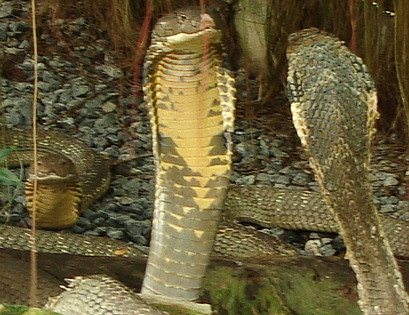
The kings in these photos are all beaten up from bashing their faces against the cages at a snake show in Thailand. In the wild, they are so beautiful… majestic, amazing snakes. I was so glad to see my first one in the wild. Even better to interact with it. Gotta love Thailand!
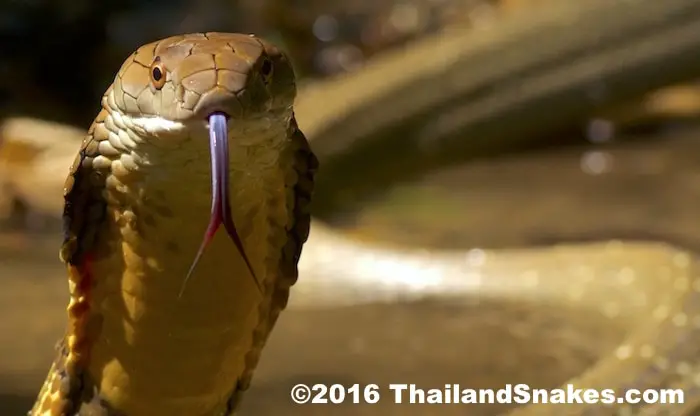
This page is focused on King Cobra (Ophiophagus hannah) snakes because their demise is imminent here in Thailand, and already in most countries they are not found in near the numbers they once were. On the island of Penang in Malaysia, it is said that kings can only be found very occasionally on the mountain.
They used to be common. I was lucky enough to see one there on a very steep section of the hill while descending. It was three to four meters long and much thicker than my forearm. It was in the underbrush, moving slowly, perhaps thinking it was unobserved. That was two years ago, and maybe that snake has been a meal for someone by now. It’s entirely possible.
In Thailand, I’ve watched just one snake show take over fifty king cobras each year out of the wild. They ‘rescue’ them from homes, yards, businesses, gardens, and farms. The kings spend a couple of weeks or months rubbing their faces raw and bleeding against the fence trying desperately to escape.
Some of them are put in the king cobra show – where they are teased mercilessly three to ten times each day for tourists that are interested in seeing snakes but don’t really understand the state of the kings that are held there.
I cannot imagine that king cobras as a species have more than another few years of existence in Thailand, Malaysia, Philippines, Laos, Singapore, and Taiwan.
The IUCN Red List site lists king cobras as ‘Vulnerable.” Kings are being collected and sold in great numbers to buyers in Bangkok who cook them up as a meal or send them on to China for the same purpose.
It wasn’t long ago that the Queen Saovabha Snake Farm – “The Red Cross Snake Farm” in Bangkok was ‘broken into’ and something like seventy king cobras were ‘stolen.’ Hmm, wonder where they went. Seventy king cobras had to fetch a nice price, I’d think. Tens of thousands of US Dollars – easy. Not accusing, it’s just a very sad state of reality for these and other snakes poached for their skin, blood, bile ducts, tongues, and meat.
So this page will be a collection of all the best information I can source about my favorite species of snake, King Cobra – Ophiophagus hannah. If you have some article, book, documentary, photo, video, or other bit of information you’d like to see listed here, just write via the contact form at this link. It is found under the HOME menu at the top of all pages.
Video of a King Cobra breathing – Listen – You Can Hear It:
Update – I’ve seen a number of king cobras in the wild now over the years. Four of them have been hundreds of meters high on mountains. Many snake enthusiasts want to come to Thailand to see king cobras, and I have to tell them… the chance of seeing one is slight. I’ve lived in Thailand for ten years and I’ve seen only a handful, and I’m in the rainforest often.
Your best bet is to come to the country and stay for a couple of months. Stay at PhanomBenchaMountainResort.com in a bungalow, and hike during the days around there. That’s my best advice. Your chance of seeing a king cobra is not high – you would probably need weeks of walking around during the day to see one. It’s all luck!
Thais are a bit crazy about cobras – it is the most easily recognized snake, and though I have met few people that can identify other snakes, most know what a cobra looks like.

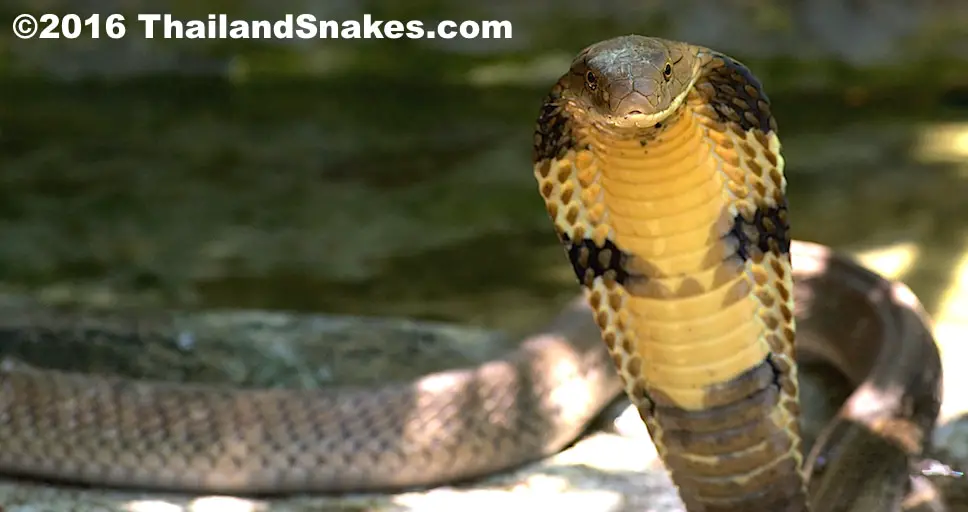
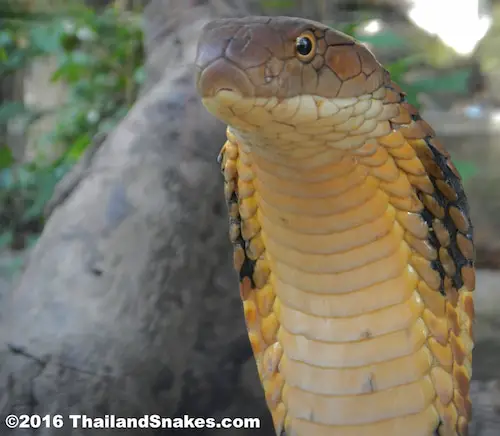
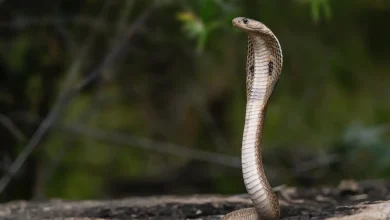
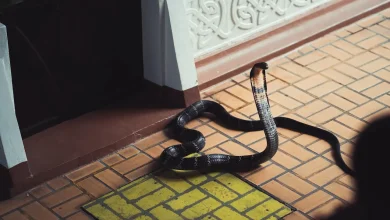
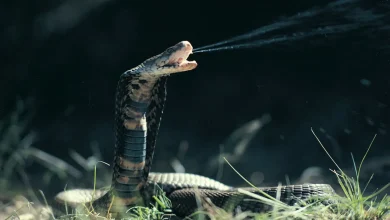
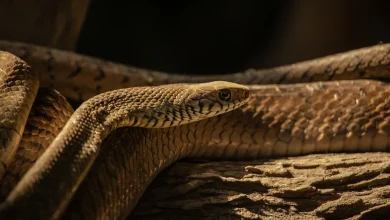
i think its a very unique animal, its quite scary though, but i find it very amuzing, one of my friends got a king cobra tattooed on her arm and it looks down! i think this website is helpful incase one day we come face to face with one of theese dangerous creatures:]
I have a King Cobra living under my house in Roi-et, Thailand (there may be a pair of them… I’m not sure). I ran into it only once and it was an amazing creature. However, when I came across it, it was moving VERY fast trying to escape my little dog that was nipping at its tail. It was so damn big, I was left breathless. It slithered right in front of me and didn’t seem to take any notice of me at all. It only seemed interested in getting away from my little dog (which I’m sure would have been only a small snack for him). It went directly toward my house and started knocking it’s head against the smoked glass sliding door. I can only assume that it thought there was a dark cave there. Eventually it slithered into some tall grass. I wanted to see more of it but reason got the better of me. I’m sure it’s still there but thankfully, I’ve only run into it that one time.
Wow, wish it was me. You can call the ambulance people or the police and they’ll send a guy that picks up the king cobra for you. Not sure what they’ll do with it – but at least it won’t be under your house.
Hi Vern,
Great site!
So – if you come face to face with a King Cobra do you freeze or leg it?
Also, do you know if it’s possible to buy the anti-venom anywhere in Thailand (or elsewhere if not here)?
Tom.
Hi Tom,
Hmm, good question. Probably better to leg it! But, if you are very close, freezing is best. They strike as you back away, so unless you’re moving fast, don’t bother. Another thing, they can only strike lower than their heads. All the major hospitals have the antivenin, or can get it from the Queen Saovabha Snake Farm in Bangkok. Cheers man, Vern
Hey, do you have any photos of juvenile King Cobras? The info above says they have yellow bands across black bodies. I ask because around the beginning of the year I was riding a bicycle on the road out of Ob Khan NP and stopped as about a dozen little black snakes with a yellow band across their “neck” were slithering across the road. They would have been coming from a creek bed area. I know nothing of snakes other than the old adage to treat every snake as though it’s venomous. Actually, the only live cobra I’ve seen has been on that same road, smack in the middle, when I stopped at the top of a hill. He wouldn’t move and since it was a single lane I didn’t feel I had enough clearance to get past him. He was erect with his hood flared. I attempted to throw rocks near him (not at him) in hopes of moving him along (it was getting dark and I wanted to get out of the park). Every time a rock would land, he’d react to it, but not move. Finally, a jeep came along and ran over him, I heard a bang (like a balloon popping) and then saw the snake slither off to the side of the road and I still road past as fast as I could and as far away as possible.
Here’s a photo of a pal, Luke Yeomans, hand holding one. You can get the idea though it isn’t a back shot – https://www.facebook.com/ThailandSnakes. I just posted it on our facebook page there.
Realy, king cobra is a Monsters snake . I don’t know why but I love this snake.
I was at Phu Mu Thailand in 1970 & 71. A fellow GI said he saw a King Cobra on site that was in a drainage ditch and he was in an Army 2 &1/2 ton truck. He said it reared up and was looking in the window at him as he eased by. Knowing the height of the truck and the depth of the ditch I estimated that it was reared up 11′. Now figure how high a King Cobra can rear up. If it can rise 1/2 of its body up then it was 22 foot. It long. He said at the time that it was almost as big around as a soccer ball. Now remember that Phu Mu mountain was a spiritual mountain jungle that the local natives stayed off of and thus lots of wild life to include tigers, black panthers, bears, and every type of snake imagineable.
Dear Friend
We are planning to open a snake park in Angola. We want to house African snakes, but would also like to house King Cobra, rectangle pythons. Is there a legal way to export the snakes to Angola?
No.
Vern, i need help to ID a snake that looked like a juvenile king cobra l,it was trying to enter our house in chiangmai province..where can i send it ?
https://thailandsnakes.com/thailand-snake-identification-form/
Hallo my friends,
we was at your snake farm in Krabi. We know the owner Panya and the guy in the video is named Jacky.
It is a very nice snakefarm.
And you have a very great webside and it is a goood idea to make herping in Thailand.
We comes very often to Thailand, I think we was about 20 times there. We hope to see and visit you in Thailand. You make a very good job mate.
Keep on,
greetings
Jon Vasilev
Hi Jon – thanks for your note! The snake farm is privately owned, I have no interest in it. I was there so many times over the years and I tried to educate staff working there, but I don’t think I was very successful. Anyway, cheers man – hope you make it back to Thailand another 20 times too!
Dear Vern,
We have a villa in Ao Nang and have had a number of snakes over the years in our garden not too much of a problem as we kept our distance and figured they would keep their’s. Recently we started to rent the villa out so built a high wall around to try and keep snakes out. Just this week our Gardner found 4 juvenile king cobras and our neighbour’s dog was killed by an adult king cobra. We have guests arriving tomorrow and are wondering what we can do? Will the juveniles be living in their nest or do they leave their nest when they hatch? Do you have any suggestions of how we can get them out of our garden? Can you give advice over the phone?
Best regards, M
Dear Vern,
I don’t have any comment but want to ask for your photos for a short article about venomous snakes of Cambodia for local magazine and would like to ask for your photos. Can you send me the photo of king cobra, monocled and spitting cobras and i will be credit you.
Thanks.
Best wishes,
Thy
When you said it was black – they probably thought it was a monocled cobra. Could have been. Could have been a wolf snake (harmless). Hard to guess… Cobras are nothing to mess with!
Feel free to use the photos you find on this site – and just credit me with ©2016 ThailandSnakes.com. I don’t have time to go find pics and send them to you. Cheers!